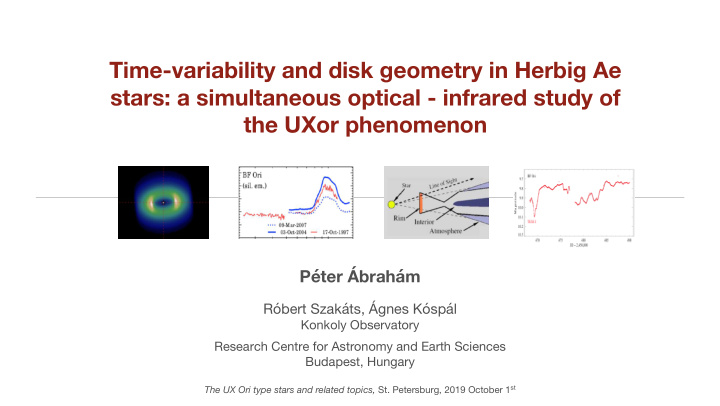



Time-variability and disk geometry in Herbig Ae stars: a simultaneous optical - infrared study of the UXor phenomenon Péter Ábrahám Róbert Szakáts, Ágnes Kóspál Konkoly Observatory Research Centre for Astronomy and Earth Sciences Budapest, Hungary The UX Ori type stars and related topics, St. Petersburg, 2019 October 1 st
Optical variability of Young Stellar Objects • YSOs are well-known about their optical and near-infrared variability. Three main classes of variability (Herbst et al. 1994): • Type I - Cool spots: similar to sunspots, rotating for a few periods • Type II - Hot spots or zones: variable veiling continuum arising in small transient hot regions where accretion energy is dissipated (periodic or irregular). Mainly later spectral type. Light curve of UX Ori • Type III - Variable obscuration. Mainly earlier spectral type. Most studied type is the UXor phenomenon: protocometary clouds or Type II-III are related to the disk! protocomets (Grady et al. 2000), hydrodynamic fluctuation in the disk surface (Bertout 2000), puffed-up inner rim (Dullemond et al. 2003)
Variability at thermal infrared wavelengths • Infrared disk emission was long assumed to be constant (but eruptive stars) • IRAS variability flag showed definite changes (Prusti & Mitskevich 1994) • Recent mid-infrared photometric studies: a large fraction of YSOs are variable in the thermal infrared (70-80% of YSOs are variable above the 0.1 mag level, e.g. Barsony et al. 2005, Morales-Calderón et al., 2009, Luhman et al., 2010) Morales-Calderón et al. (2011)
Observable disk changes in the infrared Light echo around a protostar (Muzerolle Warp in the disk of LRLL 31 (Muzerolle et al. 2009) et al. Nature, 2013, Balog et al. 2014) Dust clouds lifted up by turbulent motions the disk atmosphere (Turner et al. 2010) Dimmings caused by orbiting dust structures (RZ Psc, credit: ISRO)
Radiative transfer models of light variations Schwore et al. (2017) Kesseli et al. (2016)
Radiative transfer models of light variations 1au Schwore et al. (2017) Kesseli et al. (2016)
Konkoly mid-infrared spectral variability atlas (Kóspál+ 2012) Mid-infrared spectroscopy from ISO and Spitzer Seven well-known Uxors in the sample Strong silicate feature variability detected
The Konkolyvar program (2009-10) A 14-day quasi-simultaneous monitoring program with daily cadence, in 2009 Sep-Nov. UX Ori type targets: BF Ori, RR Tau, SV Cep, VV Ser, UX Ori, V517 Cyg, VX Cas, WW Vul Observations: Schmidt telescope, Konkoly Observatory Ø Optical BVRI: Piszkéstet ő Obs. (Hungary), Teide Obs. (Spain); Ø Near-IR JHK: Teide Obs. (Spain); Ø Mid-IR 3.6 and 4.5 µm: Spitzer Space Telescope (NASA) Spitzer Space Telescope (Credit: NASA)
BF Ori
BF Ori RR Tau
SV Cep UX Ori
V517 Cyg VV Ser
VX Cas WW Vul
V517 Cyg
V517 Cyg
RR Tau VX Cas
V517 Cyg Scaling multiband light curves to match the amplitude of Ic, assuming pure extinction. After scaling, B, Ic and 4.5 micron light curves run parallel A homogeneous extinction of the star and the inner disk Two similar cases: RR Tau, VX Cas 3/5 3/5 fa fadin ing g events are pure extin inction ion 1 au
BF Ori
BF Ori WW Vul
BF Ori WW Vul BF BF Ori Ori : simultaneous optical-infrared fading: patchy obscuring clump, clear to the star? WW V WW Vul: : no eclipse in the optical: rotation of a bright disk area? Dmag 2/5 2/5 fa fadin ings gs are comp omple lex events Kesseli et al. (2016)
SV Cep
SV Cep • B9-A0-type star • ISOPHOT data • Long-term variability • Optical-MIR anticorr. • Optical-FIR corr. • Optical change: Av • RT modeling: changing inner rim (Juhász, Prusti, Ábrahám, Dullemond 2008)
TESS: UX Ori
TESS: UX Ori
TESS: WW Vul
TESS: WW Vul
TESS: BF Ori
Summary UX UX Ori i type stars exhib hibit it strong ong varia iabilit ility in in the he mid mid-infr infrared Variati Var ations of th the e 10 micr crometer eter silicate cate em emission featu eature e (Kó (Kóspál ál+ 2012) We We m monitored 8 8 U Uxo xors i s in 2 2009, a , and d detected 5 5 d dimming e events In In 3/5 cas cases es pu pure e ex exti tincti ction with th a a single e Av ex expl plai ains th the e light t cu curves es In In 2/5 cas cases es opti ptical cal an and d infrar ared ed flux ev evoluti tion di differ er, more e co compl plex ex ex expl plan anati ations The already kn known anti-co correl elati ation betw between een opti ptical cal an and d mid-infr infrared flux fluxes of of SV SV Cep were detected TE TESS SS will ill prov ovid ide superior ior op optic ical l phot otome ometry for for ou our sou ources Thanks for your attention!
Recommend
More recommend